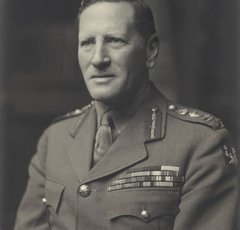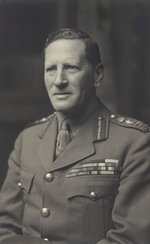Place of birth
Place of death
Marrakech, Morocco
About
Claude John Eyre Auchinleck was born into a military family in 1884. He attended the Royal Military Academy at Sandhurst and passed with marks just high enough for a career in the Indian Army. In 1904 he joined the 62nd Punjabis. Auchinleck was renowned for his rapport with Indian soldiers and showed an aptitude for learning Indian languages which made him very popular among ordinary Indian soldiers. During the First World War, Auchinleck served as a captain in Egypt, defending the Suez Canal, before being stationed in Mesopotamia, where he was subsequently promoted to the rank of brigade-major. After the end of the war, his career stalled. He attended the Imperial Defence College in 1927, and was an instructor at the Staff College in Quetta from 1930 to 1932. In 1933, he became Commander of the Peshawar Brigade, and in 1936 Deputy Chief of the General Staff in India.
Auchinleck was heavily involved in the modernization of the Indian Army and very much in favour of Indianization, replacing British officers with Indian officers. He was sent to England in 1940 to help with the preparation of the 4th Corps, which was posted to France, before moving to Norway. Here, his fraught relationship with Churchill, then First Lord of the Admiralty, emerged, with Auchinleck insisting on more supplies, artillery and air cover. Auchinleck’s insistence was correct as the under-equipment and mismanagement of the campaign led to the defeat of Norway. On his return, Auchinleck was instructed with the formation of the 5th Corps for the defence of the south of England in case of a German invasion. In July 1940 he was promoted to the rank of general officer. His antagonistic relationship with Montgomery, who served under him then, dates back to his time at southern command. In November 1940 Auchinleck was promoted to the rank of general and appointed Commander-in-Chief of the Indian Army as India’s strategic importance in the war effort increased. Churchill later decided to appoint Auchinleck as Commander-in-Chief of the Middle East to relieve Wavell, swapping their roles in June 1941 after the failure of Operation Battleaxe. Churchill was impatient for a successful campaign in North Africa; however, Auchinleck forewarned him that the inadequate equipment and training of the soldiers would make the success of such an operation doubtful. Auchinleck’s perseverance led to the successful operation at Tobruk in November 1941. However, a series of misjudgements on his part resulted in a crushing defeat in June 1942, with the British Army being pushed back to El Alamein. This led to Churchill’s decision to remove him from his post, replacing him with Montgomery.
Auchinleck returned to the post of Commander-in-Chief of the Indian Army on Wavell’s appointment as Viceroy of India in June 1943. Auchinleck organized the expansion of the Indian Army as well as the provision of bases, troops and supplies for the campaign in Burma to counter the Japanese attacks. In 1946 Auchinleck was promoted to field marshal. Auchinleck remained in India until 1947 and was in charge of preparing the Indian army for the handover of power. Auchinleck was committed to the idea of a united India and had hoped that the Indian Army would remain undivided; however, he quickly became aware that partition and the division of the army were inevitable. Auchinleck needed to ensure that the command structures remained intact once all British officers returned to the UK after independence. His efforts were hampered by Mountbatten’s decision to bring the date of independence and partition forward from 1 June 1948 to August 1947. The division of the Indian Army as well as religious conflict within the army itself rendered it ineffectual to counter the partition violence and to restore law and order. Auchinleck stayed on as Supreme Commander of the Indian and Pakistan forces after independence. As his relationship with Mountbatten grew increasingly hostile, he was asked to resign in September 1947. He left India in December 1947. In 1968 he retired to Marrakech, where he died in 1981.
Aga Khan, Leopold Amery, Clement Attlee, Ayub Khan, Ernest Bevin, Winston Churchill, Stafford Cripps, Lord Curzon, M. K. Gandhi, Firoz Khan Noon, Louis Mountbatten, Jawaharlal Nehru, Francis Younghusband, Lord Zetland.
Operations in the Middle East from 1 November 1941 to 15 August 1942 (London: HMSO, 1948)
Cornell, John, Auchinleck: A Biography of Field-Marshal Sir Claude Auchinleck (London: Cassell, 1959)
Elliott, J. G., A Roll of Honour: The Story of the Indian Army, 1939–1945 (London: Cassell, 1965)
Greenwood, A. A., Field-Marshal Auchinleck (Durham: Pentland Press, 1990)
Parkinson, Roger, The Auk: Auchinleck, the Victor at Alamein (London: Hart-Davis MacGibbon, 1977)
Warner, Philip, Auchinleck: The Lonely Soldier (London: Sphere, 1982)
Mss Eur D 1196, Letters to R. A. Newman, Asian and African Studies Reading Room, British Library, St Pancras
Correspondence with Sir Thomas Riddell-Webster, Imperial War Museum, London
Private papers, University of Manchester
For image and copyright details, please click "More Information" in the Viewer.
Banner image credit
Thurston Hopkins/Picture Post/Hulton Archives via Getty Images
Image credit
Sir Claude Auchinleck by Walter Stoneman, bromide print, May 1945, NPG x163786
© National Portrait Gallery, London, Creative Commons, http://creativecommons.org/licenses/by-nc-nd/3.0/


